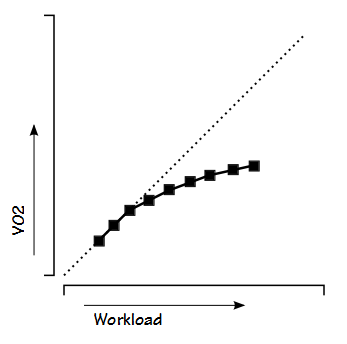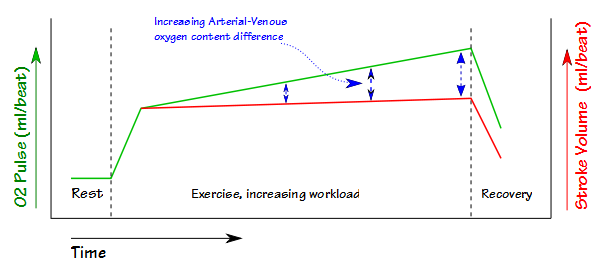I’ve been reviewing my CPET textbooks trying to get a better idea of how to differentiate between different cardiovascular limitations. The other day I ran across an article on a related subject and thought it might be instructive.
The hallmark of cardiovascular limitations is the inability to deliver enough oxygenated blood to the exercising muscles. Another limitation that has similarities to this (and one that is infrequently diagnosed) is the inability of the exercising muscle to utilize the oxygen delivered to it. The best examples of this type of exercise limitation are mitochondrial myopathies (MM).
The mitochondria are the primary source of the ATP used by exercising muscle. There are several conditions that can cause the number of mitochondria to be reduced and there is wide variety of mitochondrial genetic defects. Mitochondria have their own genes and these can have both inherited or acquired genetic defects which can cause anything from mild to severe decreases in the ability to produce ATP. Mitochondria require oxygen to produce ATP so when the number of mitochondria are reduced or their ability to produce ATP is reduced the rate at which oxygen is consumed by an exercising muscle is also reduced.
A relatively common complaint of individuals with MM is dyspnea and exercise intolerance. One study found that 8.5% of all the patients referred to a dyspnea clinic had a mitochondrial myopathy of one kind or another. A definitive diagnosis requires a muscle biopsy but because the symptoms are often non-specific and a biopsy is an invasive procedure, it is usually not performed unless there more significant evidence suggesting a MM.
In general MM affects the ability of muscles to exercise and this includes respiratory muscles. For this reason maximal inspiratory and expiratory pressures are often reduced. Since the MVV also depends on the respiratory muscles this is usually reduced as well. Unless the MM is severe however, spirometry, lung volumes and DLCO tend to be normal. A CPET is able to provide a lot more evidence but results must be analyzed carefully.
First, and perhaps most obviously, the most common CPET finding is that the maximum oxygen consumption expressed either as ml/kg/min or as percent predicted is reduced. Because the maximum heart rate is usually normal this means first that the slope of the heart rate-VO2 response will be elevated. This is the chronotropic index and is calculated as:
A chronotropic index above 1.30 indicates that the heart rate is advancing faster than it should and subjects with a MM will likely have a value at or above this threshold.
Blood lactate is occasionally elevated at rest and usually elevated post-exercise. Even when post-exercise lactate levels are within normal limits the lactate/max VO2 ratio is well above normal. Because lactic acid and carbon dioxide production are usually elevated early during exercise individuals have a hyper-ventilatory response. Ventilation is in particular elevated relative to VO2 which means that the Ve/VO2 will be elevated likely throughout exercise.
Ve/VCO2 is also usually elevated and the maximum PETCO2 is usually reduced. RER can occasionally be markedly elevated at peak exercise but this will depend on the willingness and ability of the individual to exercise to a maximal level. Interestingly, the evidence about Vd/Vt is equivocal with both normal and elevated values reported.
Despite the overall hyperventilatory response the maximum minute ventilation is usually reduced. This is partly because the maximum VO2 is usually reduced and partly because of respiratory muscle weakness.
Because the exercising muscles do not extract as much oxygen as they should, the arterial-venous O2 content difference does not decrease and in fact the venous blood can have an elevated PO2. Poor oxygen extraction by the exercising muscle has much the same effect as poor oxygen delivery. For this reason anaerobic threshold usually occurs early both in terms of workload and in terms of oxygen consumption. For the same reason the VO2-Work Rate relationship is often abnormal and tends to show patterns similar to subjects with cardiac disease.
A handful of studies have measured cardiac output in individuals with MM, either by the acetylene rebreathing method or by the Fick equation utilizing PaO2 and PvO2. When this has been done subjects with MM have shown a normal maximum cardiac output but a cardiac output/VO2 ratio that is markedly elevated relative to normal individuals. The blood pressure response is also usually normal.
There are still a number of open questions for me because there are some CPET results that have the potential to be diagnostic for MM but do not appear to have been studied. One of these is the O2 pulse pattern. Because the maximum VO2 is reduced but the maximum heart rate is normal this also means that the maximum O2 pulse will be reduced.
O2 pulse can be used as an index of stroke volume but it does not correspond exactly since it also depends on the O2 content difference between arterial and venous blood. Stroke volume tends to reach its maximum relatively early during exercise but O2 pulse usually continues to rise throughout exercise and reaches a maximum at peak exercise. The difference in patterns between stroke volume and O2 pulse is because more oxygen is extracted from arterial blood and the arterial-venous O2 content difference increases.
But because the arterial-venous O2 content difference in MM remains low, this would imply that the O2 pulse should plateau early. Several studies have stated that the maximum O2 pulse is low, but none of them have discussed the O2 pulse pattern during a CPET so the presence of a plateau is unclear.
Additionally, most studies of CPETs in patients with MM have discussed the elevated Ve/VO2 but only a few have even mentioned Ve/VCO2 and then usually only at peak exercise. I would presume that because ventilation is elevated because of increased lactic acid as well as an increased VCO2 that the Ve-VCO2 slope would also be elevated but some confirmation of this would be appreciated.
CPET results on an individual with a mitochondrial myopathy usually show:
- reduced maximum VO2
- elevated Ve/VO2
- early Anaerobic threshold
- elevated RER
- normal maximum heart rate
- elevated chronotropic index
- reduced PETCO2
- normal blood pressure
This pattern however, is similar to individuals with a cardiovascular limitation. The primary differences between a mitochondrial myopathy and a cardiac limitation are:
- normal cardiac output
- reduced arterial-venous O2 content difference
- elevated blood lactate
and these values can only be measured either invasively or with specialized testing equipment. Routine CPET results can therefore lead you to suspect a mitochondrial myopathy, but cannot be definitive.
There is a spectrum of mitochondrial disorders. Depending on the specific defect an individual may exhibit some or all of the limitations noted here. The studies that have assessed the exercise response in individuals with mitochondrial myopathies are occasionally contradictory and this is probably due to differences in specific mitochondrial defects contained within their study populations.
Taken individually, the limitations are somewhat non-specific. Although MIP, MEP and MVV tend to be reduced, pulmonary function results are usually normal. The overall CPET pattern is similar to individuals with a low cardiac output secondary to cardiac disease with the major exception that cardiac output is normal. Because of this, individuals that show this overall pattern without any sign of cardiac disease should at least be considered for a mitochondrial myopathy.
Update:
A primarily cardiovascular limitation to exercise is discussed at greater length in How does a CPET show a cardiac limitation?
References:
Clay AS, Behnia M, Brown KK. Mitochondrial disease. A pulmonary and critical-care medicine perspective. Chest 2001; 120: 634-648.
Dandurand RJ, Matthews PM, Arnold DL, Eidelman. Mitochondrial disease. Pulmonary function, exercise performance and lactate levels. Chest 1995; 108: 182-189.
Flaherty KR, Wald J, Weisman IM, Zeballos RJ, Schork MA, Blaivas M, Rubenfire M, Martinez FJ. Unexplained exertional limitation. Characterization of patients with a mitochondrial myopathy. Am J Respir Crit Care Med 2001; 164: 425-432.
Haller RG, Lewis SF, Estabrook RW, DiMauro S, Servidei S, Foster DW. Exercise intolerance, lactic acidosis, and abnormal cardiopulmonary redulation associated with adult skeletal muscle cytochrome c oxidase deficiency. J Clin Invest 1986; 84: 155-161.
Taivassalo T, Abbot A, Wyrick P, Haller RG. Venous oxygen levels during aerobic forearm exercise: An index of impaired oxidative metabolism in mitochondrial myopathy. Ann Neurol 2002; 51: 38-44.
Taivassalo T, Jensen TD, Kennaway N, DiMauro S, Vissing J, Haller RG. The spectrum of exercise tolerance in mitochondrial myopathies: a study of 40 patients. Brain 2003; 126: 413-423.

PFT Blog by Richard Johnston is licensed under a Creative Commons Attribution-NonCommercial 4.0 International License



Good blog. Very informative. Are there any blood Tests to support clinical suspicion of MM disorders in addition to CPET?
From what I’ve read a muscle biopsy is required but I’ve been focused on the PFT and CPET aspects. Page 426 of the Flaherty et al article (Am J Respir Crit Care Med 2001; 164: 425-432) has several paragraphs devoted to the biopsy evaluation process as does page 3404 of the Jeppeson et al article (Brain, 2006; 129: 3402-3412).
Richard Johnston. With mitochondrial myopathy, peripheral skeletal muscles and the heart muscle are affected. Cardiomyopathy is developing. Therefore, there are limitations on the part of the heart. But why does the cardiac output not suffer? And CPET yet the picture is very much like the one of the young people.
Andrey –
Cardiomyopathy is not necessarily a consequence of a mitochondrial myopathy. First, a mitochondrial myopathy is not an all-or-nothing sort of thing; there are different degrees of impairment ranging from very mild to life-threatening. Second, there are both inherited and acquired mitochondrial myopathies and the ones that are acquired do not necessarily reside in all cells. The CPET picture tends towards a low VO2 at anaerobic threshold and a high HR-VO2 slope but these findings are not specifically diagnostic for a mitochondrial myopathy. Measuring cardiac output during exercise is very difficult and you can suspect it is occurring but without indwelling arterial and venous catheters you can’t verify it. This is why diagnosing a mitochondrial myopathy is hard and usually requires a tissue biopsy. I suspect that mitochondrial myopathies are far more common than we expect but until better, simpler and cheaper tests become available we’ll never know for sure.
Regards, Richard
The study is small, but on the topic. Gimenes A. C. et al. Relationship between work rate and oxygen uptake in mitochondrial myopathy during ramp-incremental exercise //Brazilian Journal of Medical and Biological Research. – 2011. – Т. 44. – №. 4. – С. 354-360.
Andrey –
It looks like a good quality study and the results are mostly what I would expect. But unless you know a specific individual has a mitochondrial myopathy the results are not significantly different from patients with cardiac disease.
Regards, Richard